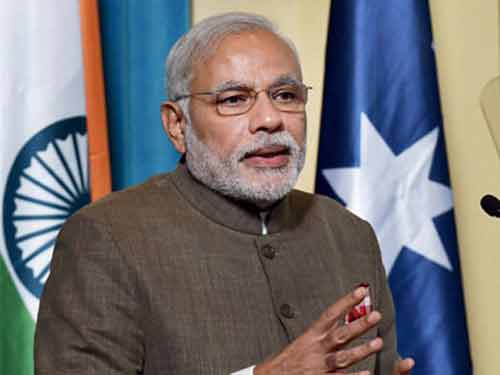
New Delhi, India (BBN)-Indian Prime Minister Narendra Modi will be starting on his yet another foreign trip in June, this time to a country with which we share the longest land border exceeding 4,000 km- Bangladesh.
Modi’s Bangladesh visit would be laden with a strategic agenda and will have the potential to be the most substantive visit he has undertaken till now to any of the SAARC countries, reports the Firstpost.com.
If all goes well, his visit to Bangladesh would put a primary structure of a parallel SAARC minus the troublesome neighbour Pakistan in place.
It would set up the first bricks in the BBIN architecture as noted earlier.
Intra-regional SAARC connectivity will be a high point of Modi's visit to Bangladesh where the concept of BBIN (Bangladesh, Bhutan, India and Nepal) is set to start off.
Bus and rail corridors are among the primary focus of Modi's visit.
The bus corridor may take off in right earnest as part of PM Modi’s Bangladesh visit agenda and the rail corridor too would come up for discussion, though it would likely be left for second phase of the sub-regional push under the BBIN framework.
The exact dates of PM Modi’s Bangladesh visit have been kept under wraps.
He intends to spend two nights in Bangladesh. Two possible dates are doing the round- 5-7 June or 8-10 June.
A formal announcement about this can be expected in a week’s time.
India-Bangladesh bilateral relations have been fortified by the fact that India recently cleared the 41-year-long logjam over the Land Boundary Agreement (LBA) and the Indian parliament finally approved it.
The next target for the two neighbours is to sign the Teesta river water sharing agreement, which is bound to take more time and witness a protracted process before it becomes a done deal.
PM Modi is likely to be accompanied by his political rival West Bengal chief minister Mamata Banerjee on his Bangladesh visit.
Modi has of late improved his strained ties with Banerjee. If the firebrand West Bengal chief minister does travel with the Prime Minister to Bangladesh, it will signal a move forward on the Teesta issue.
Banerjee was originally scheduled to travel with the then Prime Minister Manmohan Singh on his Bangladesh visit in 2011 and the Teesta deal was set to be inked during that visit.
But Banerjee pulled out at the last minute, leaving the Teesta (as well as LBA) in the lurch.
Another major agenda during Modi's visit will be to start a direct bus service between Kolkata and Agartala via Dhaka.
The move will be seen as Bangladesh allowing road transit to India, a long standing Indian demand.
Bangladesh’s Road Transport and Bridges Minister Obaidul Quader was in India last week and had held talks with his Indian counterpart Nitin Gadkari and both agreed on the road transit.
Bangladesh is set to sweeten the deal further for India by agreeing to start the Dhaka-Shilong-Guwahati bus service. A test run was conducted a few days ago.
Besides, India and Bangladesh are also thinking about opening bus services on the Kolkata-Chittagong, Shillong-Chittagong, Khulna-Kolkata and Jessore-Kolkata routes.
The launch of new bus routes will fulfill intra-sub-regional road connectivity under the BBIN framework that India is keen on pushing.
Moreover, India and Bangladesh have already done a lot of spade work towards signing the BBIN motor vehicle agreement and this important document is likely to be signed during PM Modi’s Bangladesh visit.
Once this agreement is signed, private, public and commercial vehicles will be able travel to any of these countries without any hassles and tourists will be allowed to travel on private transport between these countries. Also, permitted public bus services and commercial vehicles like those carrying goods will also be allowed without transshipment.
This agreement is key to PM Modi’s SAARC connectivity push which he had pitched during last year’s Saarc Summit in Kathmandu but Pakistan opposed that.
The idea of BBIN will ensure that sub-regional road connectivity is put in place bypassing Pakistan.
Other crucial agreements expected to be signed during Modi’s Bangladesh visit are as follows:
Building a bridge between Ramgarh in the Chittagong Hill Tracts and Subrum in Tripura.
After the bridge is constructed, two land ports will be built in Bangladesh and India and there will be a four-lane 58km road touching Ashuganj, Akhaura and Agartala.
India and Bangladesh will sign an agreement to export Bangladesh’s unused submarine cable bandwidth.
Bangladesh Submarine Cable Co Ltd (BSCCL) and the Bharat Sanchar Nigam Limited (BSNL) would be signing the deal.
The Bangladesh cabinet approved the draft agreement on 20 April after noting that it would not impact internet service in Bangladesh.
The deal will be in force for four years. The cable will go via Brahmanbarhia and India’s Agartala from Cox’s Bazar, the lone landing station of the submarine cable in Bangladesh.